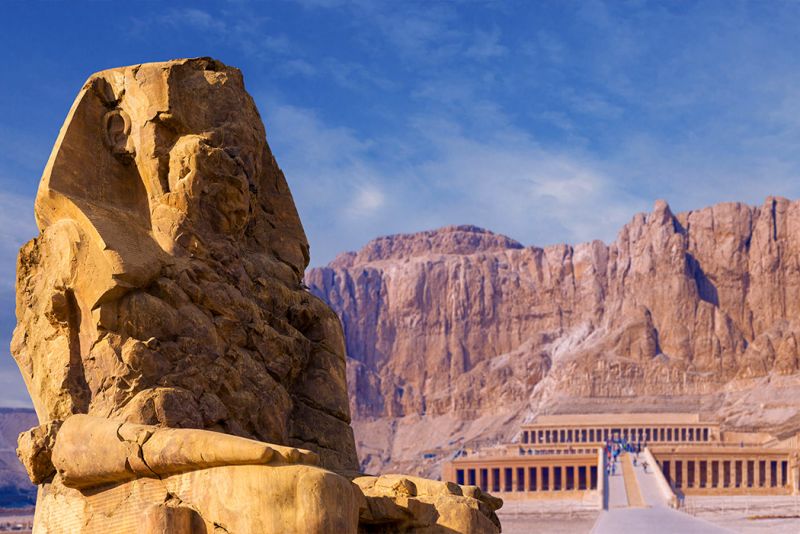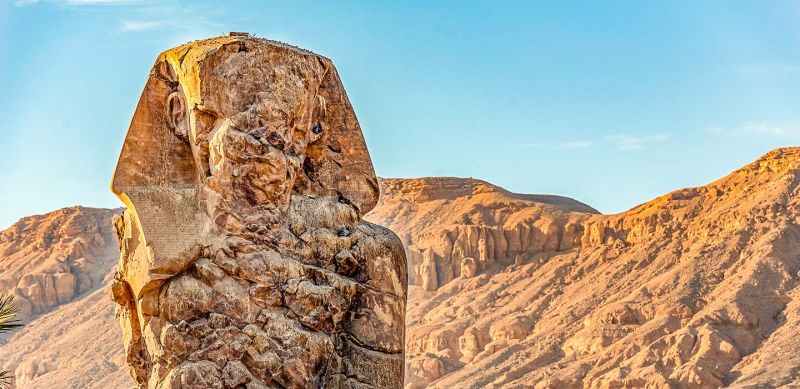Colossi of Memnon
When was the Colossi of Memnon built?
Pharaoh Amenhotep III reigned in Egypt during the 18th Dynasty from 1386 to 1349. During his kingdom, Egypt experienced a time of great prosperity and artistic progress, this era was known as the Old Kingdom. During the Old Kingdom, the architectural work improved tremendously in Egypt, and most of these monuments are still standing today.
Many of these majestic monuments were built during Amenhotep III’s 39 years of reign including the Colossi of Memnon which construction was completed by 1350 BC. The Colossi of Memnon was constructed in front of which once was Amenhotep III’ temple (destroyed by an earthquake soon after its completion). Amenhotep Temple served as a funerary temple to the Pharaoh Amenhotep III. Due to an earthquake at 27 BC the Colossi of Memnon was partially destroyed and then restored by Roman emperors during the Roman Empire in ancient Egypt.
The origin of Colossi of Memnon’s name
Its modern Arabic name is Kom el-Hatan but the Colossi of Memnon is better known for its Roman name, the Temple of Memnon. A hero of the Trojan War, Memnon was a king of Ethiopia who traveled with his army from Africa to Asia Minor to help defend the beleaguered city under attack but it was slain by the Achilles.
Memnon’s name whose means the steadfast or resolute, was the son of Eos, known for being the goddess of dawn. Memnon was associated with the Colossi many years after its construction due to the cry at dawn of the northern statue also known as the “Vocal Memnon.” Memnon’s eventually became known as the “Ruler of the West.”
The Guardians of the Gate: What was the Colossi of Memnon used for?
It was acting as guardians to the Temple of Amenhotep III. The Colossi of Memnon was meant to protect the Pharaoh’s temple from evil. Even though after the temple was destroyed by a severe earthquake, the Colossi of Memnon remains standing strongly for thousands of years
- Where is the Colossi of Memnon located?
- When was the Colossi of Memnon built?
- The origin of Colossi of Memnon’s name
- The Guardians of the Gate
- The Legend of the Vocal Memnon
One of the biggest tourist attractions in Luxor, the Colossi of Memnon gained its popularity due to its majestic appearance and for the mysterious sounds emitted by the northern colossus statue at every sunrise.
Where is the Colossi of Memnon located?
In the West Bank of Luxor Egypt, two magnificent twin statues image of pharaoh Amenhotep III and two smaller statues carved by his feet (one being his wife and the other his mother), stands graciously in the horizon of the magnificent Luxor horizons.
The two statues, each measuring 60 feet tall, stands in the entrance of Amenhotep III’s mortuary temple. They are famously named by the name of Colossi of Memnon due to a phenomenon produced by one of the statues after an earthquake.
Originally built in the Theban Necropolis in the west of the Nile River in the modern city of Luxor, the Colossi of Memnon, two colossal statues made of quartzite sandstone, which archaeologists believe was quarried at El-Gabal el-Ahmar, located near modern Cairo and then transported 420 miles overland to the ancient city of Thebes, remain after thousands of years.

When was the Colossi of Memnon built?
Pharaoh Amenhotep III reigned in Egypt during the 18th Dynasty from 1386 to 1349. During his kingdom, Egypt experienced a time of great prosperity and artistic progress, this era was known as the Old Kingdom. During the Old Kingdom, the architectural work improved tremendously in Egypt, and most of these monuments are still standing today.
Many of these majestic monuments were built during Amenhotep III’s 39 years of reign including the Colossi of Memnon which construction was completed by 1350 BC. The Colossi of Memnon was constructed in front of which once was Amenhotep III’ temple (destroyed by an earthquake soon after its completion). Amenhotep Temple served as a funerary temple to the Pharaoh Amenhotep III. Due to an earthquake at 27 BC the Colossi of Memnon was partially destroyed and then restored by Roman emperors during the Roman Empire in ancient Egypt.

The origin of Colossi of Memnon’s name
Its modern Arabic name is Kom el-Hatan but the Colossi of Memnon is better known for its Roman name, the Temple of Memnon. A hero of the Trojan War, Memnon was a king of Ethiopia who traveled with his army from Africa to Asia Minor to help defend the beleaguered city under attack but it was slain by the Achilles.
Memnon’s name whose means the steadfast or resolute, was the son of Eos, known for being the goddess of dawn. Memnon was associated with the Colossi many years after its construction due to the cry at dawn of the northern statue also known as the “Vocal Memnon.” Memnon’s eventually became known as the “Ruler of the West.”
The Guardians of the Gate: What was the Colossi of Memnon used for?
It was acting as guardians to the Temple of Amenhotep III. The Colossi of Memnon was meant to protect the Pharaoh’s temple from evil. Even though after the temple was destroyed by a severe earthquake, the Colossi of Memnon remains standing strongly for thousands of years.